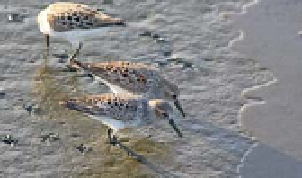Biology Reference
In-Depth Information
include Dunlin, Western, and Least Sandpipers. In winter, all have mottled
brown backs and snow-white bellies. These tiny birds use their relatively
long beaks to probe mud and sand for invertebrates. Peeps comprise ap-
proximately 75 percent of all shorebirds in the bay during spring migra-
tion season.
The bills of peeps and other shorebirds are cylindrical and vary in length
and curvature. Shorter beaks are best for picking prey off the surface; long
beaks are best for probing deep mud. The longer a bird's bill, the deeper it
can forage, with the effect that shorebirds often sort themselves into bands
along the tide line by bill length. Peeps stab the moist ground like mad in
search of small invertebrates. Sanderlings, in particular, often scuttle in
small groups before the waves, and startle into a swooping, synchronized
flight that alights moments later a few feet farther along the shore.
At less than 0.7 ounces and the size of a sparrow, the Least Sandpiper
(
Calidris minutila
) is the world's smallest shorebird. It frequents smaller
wetlands as well as the margins of larger wetlands, and it is typically found
in groups of dozens or hundreds rather than the gatherings of thousands
preferred by other peeps.
Its relative, the Western Sandpiper (
Calidris mauri
), weighs in at just
shy of one ounce. The Western Sandpiper is the most abundant shorebird
in California during fall and spring migration seasons, and it is the second
most abundant one during winter. Roughly 100,000 Western Sandpipers
overwinter in San Francisco Bay out of a total population of four million.
In winter months, nearly 60 percent of all of the bay's shorebirds may be
found in the mudflats and salt ponds south of the San Mateo Bridge.
Western Sandpipers make the most of a
variety of bay habitats, ranging from
mudflats and salt pond levees to tidal
sloughs, drained ponds, and seasonal
wetlands. How and when they use these
habitats depends on whether it is low or
high tide, and if they are in search of
food or refuge. (Max Eissler)
Dunlin (
Calidris alpina
) breed in the subarctic and arctic and migrate
down the Pacific Flyway to wintering grounds up and down the coast. At
two ounces, it is the largest of the estuary's peeps. A long, drooping bill
and spring and summer breeding plumage of rusty-red back feathers set
off by a black belly patch distinguish it from other peeps.
Whatever their size, most peeps split their time between the food-rich
waters of the estuary, breeding grounds in the subarctic and arctic, and
winter in Mexico and Central America. Peeps spend more time resting
and recuperating in San Francisco Bay than anyplace else they pass


